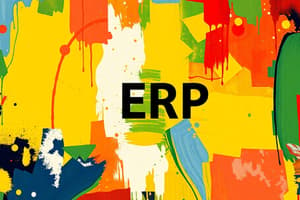Podcast
Questions and Answers
What does MRP stand for?
What does MRP stand for?
Material Requirements Planning
Which of the following are inputs to MRP? (Select all that apply)
Which of the following are inputs to MRP? (Select all that apply)
- Master Schedule (correct)
- Bill of Materials (correct)
- Customer Orders
- Inventory Records (correct)
What is the purpose of the Bill of Materials in MRP?
What is the purpose of the Bill of Materials in MRP?
To list all of the raw materials, parts, subassemblies, and assemblies needed to produce one unit of a product.
Fabrication of wood sections takes two weeks.
Fabrication of wood sections takes two weeks.
How many frames and slatted wood sections are needed for one wood shutter?
How many frames and slatted wood sections are needed for one wood shutter?
What is the cumulative lead time for assembling the shutters?
What is the cumulative lead time for assembling the shutters?
When is the 150-unit shutter order due for delivery?
When is the 150-unit shutter order due for delivery?
MRP outputs include a time-phased plan specifying timing and quantity of production for each end item.
MRP outputs include a time-phased plan specifying timing and quantity of production for each end item.
Flashcards are hidden until you start studying
Study Notes
Introduction to Operations Management
- Focus on scheduling, particularly MRP (Material Requirements Planning) and ERP (Enterprise Resource Planning).
- Reading materials include Chapters from Stevenson and Heizer & Render on Operations Management.
What is MRP?
- MRP is a methodology that converts master schedule demands for finished products into specific time-phased requirements for components and materials.
- It involves the planning and scheduling of manufacturing processes.
MRP Inputs
- Master Schedule: A timeline outlining the production schedule and delivery timelines.
- Bill of Materials (BOM): A detailed list outlining all raw materials, components, and assemblies necessary for producing one unit of a product.
- Inventory Records: Information on available materials and stock levels, tracking both independent and dependent demand.
MRP Outputs
- Planned order releases detailing the sizes and timing of necessary orders to meet production schedules.
MRP II
- An enhancement of MRP that integrates additional data such as production capacity and financials, focusing on overall resource planning.
ERP
- ERP is a comprehensive software solution that manages business processes and integrates various functions across an organization, including MRP.
Example Case Study: Wood Shutters Production
- Example involves orders for 100 and 150 shutters, due in weeks 4 and 8, respectively.
- Each shutter requires two frames and four slatted wood sections.
- Fabrication of wood sections takes one week; frames have a lead time of two weeks.
Lot-for-Lot Ordering
- Planned order releases are equal to net requirements per period, calculated based on demand and current inventory availability.
Lot-Size Ordering
- Involves ordering larger quantities (320 units for frames and 70 units for wood sections), which may lead to surplus stock.
Assembly and Lead Time Planning
- Assembly requires one week; total cumulative lead time to produce shutters is three weeks, factoring in production of frames and slatted wood sections.
Bill of Materials Example
- Detailed quantities per item required for producing one wood shutter:
- 1 wood shutter per unit
- 2 frames per shutter
- 4 slatted wood sections per shutter
Assembly Design
- Visual representation indicating the hierarchy of components and their quantities for efficient production.
Studying That Suits You
Use AI to generate personalized quizzes and flashcards to suit your learning preferences.




